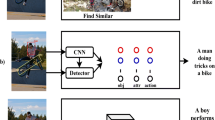Abstract
Computer technology provides new conditions and possibilities for art creation and research, and also expands the forms of artistic expression. Computer-created art has thus become one of the important forms of art. In this paper, we proposed a novel method of generating abstract paintings. We used the public painting dataset WikiArt and designed a K-Means algorithm that automatically finds the optimal K value to perform color segmentation on these images, and divide the picture into different color blocks. We proposed the concept of the collection of color block (CoCB), which records all color block information of the segmented image and serves as an intermediate vector for the generation of abstract painting. We extracted the CoCB as an empirical sample and used a learning model based on deep learning to automatically generate brand-new CoCBs. We then converted the CoCBs into an abstract painting, so that the generated abstract painting also followed certain aesthetic rules. Experiments showed that the resulting abstract painting have great visual impact, and some of them have been installed as decorations in public and private spaces, as well as art institutions. Also, some artists and designers have used the results in their work.









Similar content being viewed by others
References
Franke HW (1971) Computers and visual art. Leonardo 4(4):331–338
Judelman G (2004) Aesthetics and inspiration for visualization design: bridging the gap between art and science. In: Proceedings, eighth international conference on information visualisation. IEEE, pp 245–250
Marcos AF (2007) Digital art: when artistic and cultural muse merges with computer technology. IEEE Comput Graph Appl 27(5):98–103
King M (2002) Computers and modern art: digital art museum. In: Proceedings of the 4th conference on creativity & cognition, pp 88–94
Kandinsky W (2013) Point and line to plane, 1–4. Renmin University of China Press, Beijing
Berezhnoy IE, Postma EO, Herik JVD (2005) Computerized visual analysis of paintings. In: International conference on association for history and computing, pp 28–32
Laposky BF (1969) Oscillons: electronic abstractions. Leonardo 2:345–354
Dietrich F (1986) Visual intelligence: the first decade of computer art (1965–1975). Leonardo 19(2):159–169
Nake F (2007) Computer art: creativity and computability. In: Proceedings of the 6th ACM SIGCHI conference on creativity & cognition, pp 305–306
Molnar V (1975) Toward aesthetic guidelines for paintings with the aid of a computer. Leonardo 8:185–189
Taylor RP (2002) Order in pollock’s chaos. Sci Am 287(6):116–121
Taylor RP, Micolich AP, Jonas D (1999) Fractal analysis of Pollock’s drip paintings. Nature 399(6735):422
Taylor RP, Micolich AP, Jonas D (2002) The construction of Jackson Pollock’s fractal drip paintings. Leonardo 35(2):203–207
Zheng Y, Nie X, Meng Z, Feng W, Zhang K (2015) Layered modeling and generation of Pollock’s drip style. Vis Comput 31(5):589–600
Zhang K, Yu J (2014) Generation of Kandinsky art. Leonardo 49(1):589–600
Tao W, LiuY, Zhang K (2014) Automatically generating abstract paintings in Malevich style. In: IEEE/ACIS 13th international conference on computer and information science (ICIS), pp 201–205
Xiong L, Zhang K (2016) Generation of Miro’s surrealism. In: Proceedings of the 9th international symposium on visual information communication and interaction, pp 130–137
Kingma DP, Welling M (2013) Auto-encoding variational bayes. arXiv preprint arXiv:1312.6114
Radford A, Metz L, Chintala S (2015) Unsupervised representation learning with deep convolutional generative adversarial networks. arXiv preprint arXiv:1511.06434
Arjovsky M, Chintala S, Bottou L (2017) Wasserstein GAN. arXiv preprint arXiv:1701.07875
Gulrajani I, Ahmed F, Arjovsky M, Dumoulin V, Courville A (2017) Improved training of Wasserstein GANs. In: Advances in neural information processing systems, pp 5769–5779
Yu Y, Gong Z, Zhong P, Shan J (2017) Unsupervised representation learning with deep convolutional neural network for remote sensing images. arXiv preprint arXiv
Jian CL, Zhang Y, Li Y (2015) Non-divergence of stochastic discrete time algorithms for PCA neural network. IEEE Trans Neural Netw Learn Syst 26(2):394–399
Goodfellow I, Pouget-Abadie J, Mirza M, Xu B, Warde-Farley D, Ozair S, Courville A, Bengio Y (2014) Generative adversarial networks. In: Advances in neural information processing systems, pp 2672–2680
Elgammal A, Liu B, Elhoseiny M, Mazzone M (2017) Can: creative adversarial networks, generating“ art” by learning about styles and deviating from style norms. arXiv preprint arXiv:1706.07068
Gatys LA, Ecker AS, Bethge M (2015) A neural algorithm of artistic style. Comput Sci. arXiv preprint arXiv
Arnheim (2006) Art and visual perception 13–31. Sichuan People’s Publishing Press, Chengdu
Gray R, Linde Y (1982) Vector quantizers and predictive quantizers for Gauss–Markov sources. IEEE Trans Commun 30:381–389
Kingma DP, Ba J (2014) Adam: a method for stochastic optimization. arXiv preprint arXiv,1412.6980
Acknowledgements
This work is supported by National Natural Science Fund for Distinguished Young Scholars (Grant No. 61625204) and partially supported by the State Key Program of the National Science Foundation of China (Grant Nos. 61836006 and 61432014).
Author information
Authors and Affiliations
Corresponding author
Additional information
Publisher's Note
Springer Nature remains neutral with regard to jurisdictional claims in published maps and institutional affiliations.
Rights and permissions
About this article
Cite this article
Li, M., Lv, J., Wang, J. et al. An Abstract Painting Generation Method Based on Deep Generative Model. Neural Process Lett 52, 949–960 (2020). https://doi.org/10.1007/s11063-019-10063-3
Published:
Issue Date:
DOI: https://doi.org/10.1007/s11063-019-10063-3




